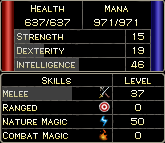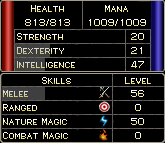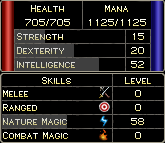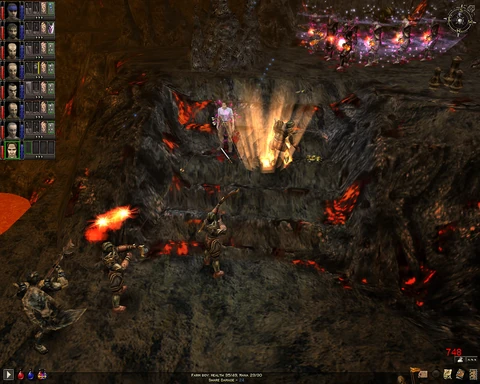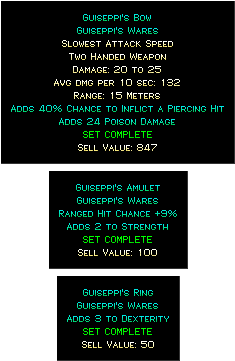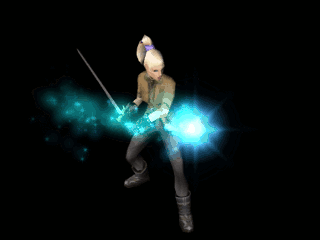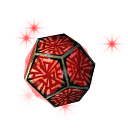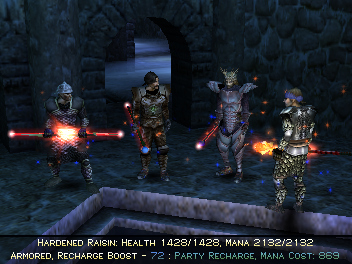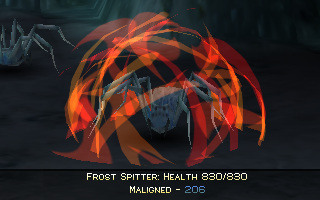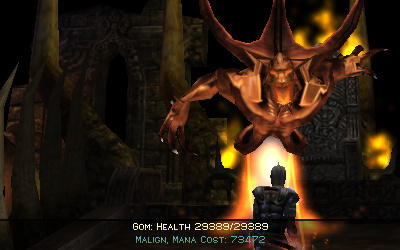This article aims to provide generally-relevant info about leveling in Dungeon Siege.
Levels[]
Skill & Attribute Tracking[]
Dungeon Siege uses a multi-step process for tracking the hero's experience.
- First, xp is earned in each of the four classes separately: Melee, Ranged, Nature, and Combat. Points are given for dealing damage, not for making complete kills. Experience is not shared by party members, which is different from Dungeon Siege II.
- If this was an attack by way of a spell, summon, or weapon swing, the skill corresponding to the attack gains xp. If the damage came by way of an item mod, such as damage reflection or a retaliatory spell trigger, the currently-active weapon/skill gains the xp.
- The engine also adds the xp to a separate, cumulative running total, something the devs call the character's uberlevel. The only time the player sees this number is in the multiplayer staging screen.
- The uber-points determine gains in three additional xp bars: those for Strength, Dexterity, and Intelligence. How this "attribute experience" gets distributed depends on the class in which the xp was earned.
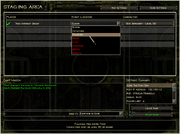
The uberlevel determines access to level-restricted content.
| Class | Strength | Dexterity | Intelligence |
|---|---|---|---|
| Melee | .64 | .27 | .09 |
| Ranged | .25 | .62 | .13 |
| Nature | .09 | .18 | .73 |
| Combat | .13 | .17 | .70 |
XP From Monsters[]
- Main article: List of Enemies - Normal (Dungeon Siege)
- Main article: List of Enemies - Veteran (Dungeon Siege)
- Main article: List of Enemies - Elite (Dungeon Siege)
Experience points tied to a monster are awarded for delivering damage as a fraction of that monster's total life. E.g., dealing 6 versus a monster with 10 life awards six-tenths of its total xp value; which if it's 15 xp, the hit is worth 9 xp to the player.
The final life and xp values are subject to multiplayer scaling, and the damage dealt by the player is subject to skill and enemy armor, and the game's difficulty scalar, which will all be discussed in later sections.
Discrete values in hitpoints and xp for all Dungeon Siege Enemies are accessible in the Logic.dsres and Expansion.dsres files. Here is a portion of the Skeleton Ranger's template as an example of how these are defined:
[actor]
{
[skills]
{
strength = 16, 0;
intelligence = 9, 0;
dexterity = 11, 0;
ranged = 36, 0;
}
}
[aspect]
{
experience_value = 12000;
life = 525;
max_life = 525;
mana = 14;
max_mana = 14;
}
[attack]
{
attack_range = 0.5;
damage_max = 119;
damage_min = 100;
}
[defend]
{
defense=312;
}
The numbers are treated as float values with 6 significant figures. With 12000 xp and 525 life, the game awards exactly 22.8571 xp per point of damage dealt in the case of the Skeleton Ranger above. Players' xp totals are saved in the following format in their own .dsparty file:
[skills]
{
combat_magic_level = 22.2345;
combat_magic_xp = 156664;
dexterity_level = 24.2891;
dexterity_xp = 43581.6;
intelligence_level = 15.0795;
intelligence_xp = 3453.37;
melee_level = 53.044;
melee_xp = 1.52634e+007;
nature_magic_level = 3.46789;
nature_magic_xp = 1871.01;
ranged_level = 3.12347;
ranged_xp = 1561.03;
strength_level = 43.7328;
strength_xp = 868983;
uber_level = 53.109;
uber_xp = 1.54211e+007;
}
There are, in practice, eight different experience bars on a character: Melee, Ranged, Combat, Nature, str, dex, int, and uber (total).
In keeping with the limit of 6 figures, high values are reckoned with scientific notation (note the melee_xp above, the bulk of the total, where 1.52634e7 = 15,263,400 xp).
Kung Fu[]
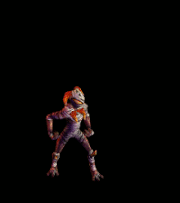
Kung Fu Expert
Normally the character's aggregate "uber" level is the sum of his skills.
But in addition to the four classes, there is also weaponless fighting, referenced internally as Kung Fu, BeastFu, or Karate, and used by all the monsters in the game that lack weapons. When the hero uses Kung Fu, simply swinging his fists with no weapon equipped, it does not earn Melee xp. It does earn uber xp, however; because of this, it generates progress in Strength, Dexterity, and Intelligence. Attribute xp is distributed the same as Melee (64% to Strength), but again, there is no increase in Melee xp, and therefore no gains in accuracy or armor penetration that the skill itself imparts.
From the above, it should also be clarified that Kung Fu training does not net the character bonus attribute point progress. As the hero's uberlevel rises, so does the difficulty of raising attributes no matter what. If anything, frequent fist fights set non fighter-types behind schedule, since it will slow the character's Dex and Int gains.
Conclusion[]
One important but possibly hard-to-grasp issue here (since all of this happens under the hood), is that the hero's total experience, the uberlevel, is what determines the price of improving STR, INT, and DEX. If the hero is uberlevel 100, he has a total of about 103 billion XP, and regardless of what class he trains in, it will take a few billion more XP to level a full attribute point. The class determines proportionally which attribute receives more training.
The practical implication for players is that one cannot switch to a new discipline and expect a torrent of fresh attribute points. The later section Example Demonstrating How Attribute Scores Increase walks through this issue with a high-level spellcaster attempting to gain Strength.
Attribute, Skill, and Stat Mechanics[]
- Main article: Character Attributes and Skills
Health[]
- Maximum health is this sum:
((str - 9) * 29.4) + ((dex - 9) * 9.8) + ((int - 9) * 9.8) + max_life
- max_life is 0 by default. Monsters, or technically anything that cannot level up, discard the attributes they've been given and use their own explicit max_life values. The formula above resolves to 49 on a new player character.
- When health reaches 0, a player falls unconscious, but can still be attacked. The player dies if additional trauma reaches 66% of their maximum health. In singleplayer, the instant the entire party goes unconscious the game is over. In multi, things are not so harsh. The player can rise from death as a ghost, and comes back to life in 60s.
- Player health recovers at a rate corresponding with Strength, in a linear fashion:
recovery rate = (str - 9) * (1.0 health / 4.0 seconds)
- The hero begins the game with 10 Strength. Each point of strength over 9 bestows health regeneration of 0.25 per second. For the rare cases that an actor with less than 10 Strength has the health recovery mechanic enabled, there is a separate formula:
recovery rate = 1.0 health / 4.0 seconds / 9 * str
- Health regeneration is normally computed continuously, meaning a pinch in every frame, as are damage-over-time effects.
Mana[]
- The player's mana pool is this sum:
(str - 9) + ((dex - 9) * 4.0) + ((int - 9) * 25.0) + max_mana_base
- max_mana_base is 0 by default, and the sum resolves to 30 on a new character. Mana recovery correlates linearly on Intelligence:
mana recovery = (int - 9) * (1.0 mana / 3.0 seconds)
- In the rare case of actors with less than 10 Intelligence being allowed to regenerate mana, the rate is simply held to the minimum, one-third of a point per second.
- Monsters typically have a definite max_mana_base value above zero. They do not use mana to cast monster spells, which all cost 0 mana, and their mana pool does not regenerate. Their mana pool serves no apparent purpose other than to be a finite amount the player can steal with the Combat spell Rip Mana.
Strength[]
- This attribute increases the character's base melee damage linearly by 1.5 per point gained. The specific formulas for the minimum and maximum damage-per-hit are:
min = 2 + floor(1.397 * (str - 10)) + weapon_min + mods max = 4 + floor(1.603 * (str - 10)) + weapon_max + mods
- STR does not increase armor penetration in LoA, nor the chance of a piercing hit, nor the to-hit chance. Before the expansion came out, the rule was that the more damage that got dealt in a single packet, the less effective the victim's armor, so STR did indirectly affect armor penetration simply by boosting melee damage then.
- As described before, each point of strength over 9 nets the character 29.4 hp and .25 hp regeneration per second. Mana is increased by just 1, with no additional regeneration. All monsters are given strength values, and it has absolutely no effect on them.
- The STR damage boost typically accounts for about a third of a melee fighter's total damage (the rest being from the weapon). Strength is required to handle most melee weapons, many armor pieces, and some ranged weapons. STR-based armor offers far better protection than DEX or INT-based armor.
Dexterity[]
- All actors gain +3 to +4 defense per point of DEX above 10; for players it is computed continuously, then rounded, as DEX xp is earned. DEX training furthermore grants a bonus to-block and to-hit in melee, which are active even when a melee weapon is not readied. The melee combat formulas are not fully understood at this time, but the DEX "scalar" of .55 is higher than that of either INT or Melee Skill. Each DEX point over 9 imparts +9.8 maximum hp and +4 maximum mana, but no improved regeneration rate in either one.
- Monsters are assigned DEX scores. It does not improve their health or mana, but it does improve their armor and hit/block rates. It is an especially crucial stat for BeastFu (natural weapon) monsters, because they gain no hit-rate boost from their Melee Skill.
- DEX is needed to fulfill the equip requirements for ranged weapons in particular. LoA also introduced DEX armor pieces for rangers.
Intelligence[]
- Each point in Intelligence over 9 increases the character's mana pool by 25 and his regeneration rate by 1/3 points per second. He also gains 9.8 hp but no improved hp regeneration. INT conveys a small effect in the melee to-hit and to-block calculations for all actors, regardless of whether a melee weapon is readied ("scalar" of .15). This stacks with bonuses from equipment, such as the +10% blocking a mage usually gets from a staff. Monsters are assigned INT scores; it helps them in hitting and blocking but does not improve their mana or spellcasting.
- Staves and Robes require INT. Robes have large enchantment loads but pathetic Armor Ratings, and LoA introduced some much better mage armor coverage to compensate. The main goal of INT training is increasing mana. Non-mages cannot afford buffs and summons at all, and even mages can have trouble sustaining an offensive spell barrage.
Armor Rating[]
- When Armor Rating takes effect against an attack, all physical and spell damage inflicted on the actor gets reduced by a percentage. Armor does not affect any blocking calculations. The percentage is determined by the armor rating versus the attacker's Skill in the type of discipline being used, with magic, ranged, and melee each scaling differently. The overall damage reduction effect is constrained between 95%, meaning very high Armor, and 5% (weak armor or an overly-skilled attacker). The formulas using each skill are:
magic damage taken = dmg * (magic_skill + 2.177) * 2.894 / defense ranged damage taken = dmg * (ranged_skill + 1.949) * 3.232 / defense melee damage taken = dmg * (melee_skill + 1.552) * 4.059 / defense
- If a level 5 ranger fires at a target with 31 armor, she deals 72.5% of the damage given on the weapon's tooltip. With 1 extra point of skill she deals 83% of the tooltip, so skill point bonuses can make a difference when fighting creatures at parity levels. The skill gradient is computed continuously, meaning that fractional levels will affect it. The ranger in this example reaches the 95% ceiling versus the 31 armor target when Skill passes 7.163.
- Both players and monsters have Armor Ratings, and their DEX scores contribute additional points, which as stated in the Dexterity section above, is about 3-4 per point of DEX over 10.
- A Piercing Hit, as well as any Piercing Damage integer generated by a magic item affix or a spell, ignores the Armor Rating mechanic. Piercing delivers the full tooltip damage.
- Pre-LoA
- In original release Dungeon Siege the rules favored high-powered attacks, with the level of penetration corresponding to the magnitude of the damage and not with the skill.
dmg taken = dmg^2 / def constrained 5% to 95% dmg
Combat Magic[]
- Levels allow the hero to meet the requirements for Combat Spells, and they increase the magnitude calculations (such as damage, duration, summoned creature stats, mana cost) of Combat Spells. In addition to having a minimum level requirement, spells have an unstated maximum level whereupon these calculations are frozen. The armor-penetration component of Skill, discussed above in the section on Armor Rating, is not frozen, however.
- Data dump of Dungeon Siege spells shows the active level range for every spell.
- Unlike martial weapon fighting, spells do not involve a hit calculation nor a skill-based firing arc function. If a spell hits an enemy collision box, it connects, and damage is assuredly dealt after mitigation by the target's Armor and any item mods that block or reduce magic attacks. Combat levels advance the hero in the "Sorcerer" title track.
Nature Magic[]
- Nature levels behave exactly as Combat levels above, with regard to Nature Spells. Nature levels advance the hero in the "Mage" title track.
Monster Spells[]
- Many monsters in Dungeon Siege use projectile attacks. They fall into three general categories:
- Ranged weapon-users, such as a Wraith Archer, employ their Ranged skill.
- Genuine spellcasters, such as a Krug Shaman.
- Monsters that appear to be using a ranged weapon but are actually throwing a spell, such as the goblins' Blaster tank.
- The latter two categories possess spells of the so-called "monster spell school," which is governed by the creature's Combat Magic skill. By convention, monster spells do not have level-dependent magnitudes and cost no mana. For practical purposes, bear the prevalence of enemy spellcasters (including the sneaky third variety) in mind when considering item mods that block or reduce magic damage.
- Some enemies in vanilla DS, which is to say those in Ehb and the Peninsula, are erroneously given Nature or Ranged skill ranks instead an appropriate Combat rank for their "monster spell." In vanilla the alluded Blaster is very dangerous, inflicting 112 damage on average against a party member with 125 Defense. When the expansion is running, the damage is reduced 95 percent against that Defense... down to 6.
Melee[]
- Melee experience levels raise the actor's to-hit and to-defend ratings versus melee only. Whether attacking or defending, the actor must have a melee weapon armed-and-readied in order for his Melee Skill to affect these calculations. The "defend rating" is not the same thing as the Armor rating, and instead presents the chance to block a swing. Dexterity and Intelligence affect the attack and defend ratings regardless of whether a weapon is readied, but these attributes are less abundant than Melee Skill. Notably, Strength is not a factor in either the attacker's or the defender's ratings. Melee levels advance the hero in the "Champion" title track.
- Melee Skill does not affect the damage range shown to you on the character sheet. However, it helps reduce the effectiveness of enemy armor, so it does improve your damage output.
- Attack and Defend scores (computed separately for attacker and defender):
rating = (melee_scalar * melee_skill) + (dex_scalar * dex) + (int_scalar * int)
- Where:
melee_scalar = .45 dex_scalar = .55 int_scalar = .15
- The exact procedure used to compare these scores during a swing is not clear; a simple best-guess is that the RNG uses them to make a weighted die roll between a hit or a block, as so:
% Chance to Block = 100 * Def rating / (Att rating + Def Rating)
- Whatever the case, the chance of a successful hit is constrained between 5% and 95%, and this is imposed after bonuses bestowed by equipment and magic mods, meaning that it is impossible to obtain a 100% block rate even with an eccentric equipage.
- When making unarmed swings, Melee Skill does not affect hit and block rates but does affect armor penetration. This issue mainly relates to creatures baring their "natural" weapons against the player. They will tend to miss more frequently than armed creatures and will usually fail to block your attacks, unless the devs thought to assign them high Dexterity. But their successful blows will pit their Melee against your Armor.
Ranged[]
- Exactly as Melee Skill, Ranged Skill does not affect the DPS displayed on the character sheet, but improving the skill quietly reduces the effect of enemy armor.
- Ranged Skill also reduces the variance of the firing arc when the actor fires a ranged weapon. Dexterity and Intelligence factor in as well, but are less important. The firing arc error function is hardcoded, but supposedly described in formulas.gas to be the following:
Error (degrees) = error_scalar × ((100 - ArcTan((dex_scalar × Dexterity + int_scalar × Intelligence + skill_scalar × Skill_level) / 14.7) × 63) / 100)
- Where:
error_scalar = 4.0 dex_scalar = .35 int_scalar = .1 skill_scalar = .55
- Ranged Skill advances the hero in the "Sharpshooter" title track.
Conclusions[]
- Skill levels are crucial for spellcasters, who need to fulfill level reqs and improve their spells' magnitudes.
- Melee Skill is not as powerful, but is still of great help overcoming foes' armor ratings. There needs to be a large difference in skill between two combatants for any noticeable contrast in their swing and block rates, however; partly due to the crowd of other factors, but also because the scaling itself is not drastic.
- Ranged Skill improves damage against armored targets. The aiming error mechanic is pretty much worthless, though. Projectiles seldom miss even without skill.
- Armor is required to thrive in Dungeon Siege. The better your Armor Rating, the less time and energy you have to spend on healing, potions, snares, concealment, kiting, and picking up the pieces after a wipeout. You earn more room for error in managing these things, and you can spend more time slaying enemies.
- The expansion pack's revised armor penetration formula has a couple of important consequences. Before, it was best to use slower, heavier bows and two-handers, and spells that delivered all their damage in a huge blast like Kill and Meteor, in order to blow through enemy armor. The problem with this damage-dependent system was that the Melee and Ranged skill levels didn't mean anything. Now, the skill levels are applied directly against armor, and it is also now more sensible to use smaller, faster weapons and spells. On the enemy side, a number of the original monsters have been unfortunately affected by these changes, which hurts the challenge of the game.
Example Demonstrating How Attribute Scores Increase[]
All the business with uberlevels (laid out in the first section) has ramifications for how players gain STR, INT, and DEX. In practice, it means that they will gain attribute points at the relatively slow rate of growth of their total experience. Sadly, you cannot bolster your weak attributes easily with a brief switch in fighting styles.
Consider the following example. A Nature mage has trained to Level 50. He suddenly has a mid-life crisis. His Strength is only 14. What is he doing to himself? He wants more Strength.
Naturally he will attempt to train Strength by switching to Melee. When he earns Melee xp, the game allocates to Strength at a 64% rate, rather than the 9% rate from Nature xp. But the difficulty here is that attribute points flow from the player's sum total xp, the uberlevel, so he has to gain quite a lot of low Melee levels to see the Strength bar complete its crawl from 14.5 to 15:
While it is easy to gain the first Melee levels by fighting level-50 foes, it takes a lot of these levels to nudge the Strength bar.
The picture below shows the moment, not-too-long afterwards, when his uberlevel has increased from exactly 50 (first pic) to exactly 51. It may be discernable from the strength bars that he has gained exactly .64 points in Strength, as per the proportional Melee gains table in the first section.
With such extensive Nature training already, it took almost 38 Melee levels starting from zero in that class, to increase the uberlevel by 1 and pick up the 64% of a Strength point.
To reach, say, 20 Strength from his original 14.5 using Melee, he needs about (20 - 14.5) ÷ .64 = 8.6 uberlevels. Due to the exponential nature of Levels, his Melee skill ends up having to surpass his Nature level in order to gain these strength points:
If he had "stayed the course" with Nature for the entirety of these 8.6 levels, he would have gained 6.3 Intelligence rather than 5.5 Strength (recall from the table that Nature is more intensive on Intelligence than Melee is on Strength).
Remarks[]
In practice, multiclassing in Dungeon Siege has generally been regarded as a poor decision, because it hampers the character's cultivation of their main attribute. The main attribute equals offense & sustain potential; this is especially so for fighters and mages, while not as much so for rangers. Here are some multiclassing nuances to think over:
- Rangers and spellcasters may be tempted to gain STR to access better armor. The problem entertained in the main example above is that they absolutely cannot achieve enough STR to wear fighter armor on par with their level.
- Combat and Nature mages can multiclass these two skills seamlessly, since they both improve INT.
- Rangers can readily try "Skirmisher" track. DEX is a valuable synergy with a shield and melee weapon, while not truly being a necessity beyond the maximum prereq for bows (specifically, this is 63 in vanilla and 70 for DEX armor in Legends of Aranna). They'll still never be as formidable as pure fighters.
- Veteran fighters should powerlevel Combat Magic to 22 and use Triple Strike. This vanilla spell does exactly what the name says. The diversion will not hamper STR growth if done late enough— say, level 40+.
- There is little else besides Triple Strike and Death Blast for a melee character to consider. Their mana pool is too pathetic. Sustaining Triple Strike will use all of it, and to excellent effect.
- Legends of Aranna stops punishing everybody for having low STR. Characters can achieve viable armor ratings with LoA equipment using their primary attribute. Also, for the most relentless treasure hunters, there is an option to find a set of rare-grade "Ogre's Might" suffix items. A stack of these can boost casters' STR high enough to wear fighters' body armor. The best place to find rare jewelry with this suffix is mid- and late-normal mode, while other coverage appears sporadically throughout normal, veteran, and elite.
XP Chart[]
The following table lists the benchmarks for each level of experience. As described above, characters make gains in eight separate xp bars: Melee, Ranged, Combat, Nature, Strength, Dexterity, Intelligence, and Uber, and all of them conform to this table. While the maximum level is 150, xp point totals can (trivially) continue to rise past the 150 threshold. Magic gear and buffs can boost the scores past their level, and the maximum nominal score in attributes and skills is 180.
These numbers are totals. You reach level 1 with 70 xp, and then level 2 with additional 580 xp.
| Level | Experience | Level | Experience | Level | Experience |
|---|---|---|---|---|---|
| 1 | 70 | 51 | 11,263,782 | 101 | 126,731,805,919 |
| 2 | 650 | 52 | 13,066,188 | 102 | 155,243,764,829 |
| 3 | 1,450 | 53 | 15,156,978 | 103 | 190,170,914,494 |
| 4 | 2,350 | 54 | 17,582,294 | 104 | 232,956,672,834 |
| 5 | 3,350 | 55 | 20,395,661 | 105 | 285,369,226,800 |
| 6 | 4,650 | 56 | 23,659,167 | 106 | 349,574,605,408 |
| 7 | 6,650 | 57 | 27,444,833 | 107 | 428,226,194,203 |
| 8 | 9,450 | 58 | 31,836,207 | 108 | 524,574,390,477 |
| 9 | 12,950 | 59 | 36,930,200 | 109 | 642,600,930,913 |
| 10 | 17,100 | 60 | 42,839,232 | 110 | 787,183,442,946 |
| 11 | 22,000 | 61 | 49,780,637 | 111 | 964,297,020,188 |
| 12 | 27,800 | 62 | 58,283,859 | 112 | 1,181,261,152,309 |
| 13 | 34,300 | 63 | 68,700,306 | 113 | 1,447,042,214,156 |
| 14 | 41,300 | 64 | 81,460,453 | 114 | 1,772,624,014,920 |
| 15 | 49,191 | 65 | 97,091,634 | 115 | 2,171,461,720,855 |
| 16 | 58,327 | 66 | 116,239,830 | 116 | 2,660,037,910,626 |
| 17 | 68,882 | 67 | 139,696,370 | 117 | 3,258,543,743,095 |
| 18 | 81,054 | 68 | 168,430,631 | 118 | 3,991,713,387,870 |
| 19 | 95,071 | 69 | 203,630,102 | 119 | 4,889,846,202,719 |
| 20 | 111,190 | 70 | 246,749,453 | 120 | 5,990,058,900,910 |
| 21 | 129,706 | 71 | 299,570,658 | 121 | 7,337,819,456,193 |
| 22 | 150,954 | 72 | 364,276,635 | 122 | 8,988,826,136,414 |
| 23 | 175,317 | 73 | 443,541,456 | 123 | 11,011,309,319,686 |
| 24 | 203,567 | 74 | 540,640,862 | 124 | 13,488,851,219,194 |
| 25 | 236,338 | 75 | 659,587,634 | 125 | 16,523,840,046,091 |
| 26 | 274,352 | 76 | 805,297,430 | 126 | 20,241,701,359,039 |
| 27 | 318,449 | 77 | 983,791,930 | 127 | 24,796,081,467,402 |
| 28 | 369,600 | 78 | 1,202,447,693 | 128 | 30,375,197,100,145 |
| 29 | 428,936 | 79 | 1,470,301,002 | 129 | 37,209,613,750,256 |
| 30 | 497,766 | 80 | 1,798,421,306 | 130 | 45,581,774,146,643 |
| 31 | 577,609 | 81 | 2,200,368,678 | 131 | 55,837,670,632,215 |
| 32 | 670,226 | 82 | 2,692,754,209 | 132 | 68,401,143,827,042 |
| 33 | 777,662 | 83 | 3,295,926,485 | 133 | 83,791,398,490,705 |
| 34 | 902,288 | 84 | 4,034,812,522 | 134 | 102,644,460,453,692 |
| 35 | 1,046,855 | 85 | 4,939,947,918 | 135 | 125,739,461,358,351 |
| 36 | 1,214,551 | 86 | 6,048,738,778 | 136 | 154,030,837,466,559 |
| 37 | 1,409,080 | 87 | 7,407,007,581 | 137 | 188,687,773,199,113 |
| 38 | 1,634,732 | 88 | 9,070,886,865 | 138 | 231,142,519,471,492 |
| 39 | 1,896,489 | 89 | 11,109,138,988 | 139 | 283,149,583,655,156 |
| 40 | 2,200,128 | 90 | 13,605,997,839 | 140 | 346,858,237,280,144 |
| 41 | 2,552,348 | 91 | 16,664,649,931 | 141 | 424,901,337,970,755 |
| 42 | 2,960,924 | 92 | 20,411,498,744 | 142 | 520,504,136,316,754 |
| 43 | 3,434,872 | 93 | 25,001,388,540 | 143 | 637,617,564,290,602 |
| 44 | 3,984,651 | 94 | 30,624,003,540 | 144 | 781,081,513,558,566 |
| 45 | 4,622,395 | 95 | 37,511,706,915 | 145 | 956,824,851,411,821 |
| 46 | 5,362,179 | 96 | 45,949,143,550 | 146 | 1,172,110,440,282,060 |
| 47 | 6,220,327 | 97 | 56,285,003,427 | 147 | 1,435,835,286,648,100 |
| 48 | 7,215,779 | 98 | 68,946,431,776 | 148 | 1,758,898,223,446,500 |
| 49 | 8,370,504 | 99 | 84,456,681,504 | 149 | 2,154,650,321,024,540 |
| 50 | 9,709,985 | 100 | 103,456,737,421 | 150 | 2,639,446,640,557,650 |
Exponents and Grind[]
Since experience is awarded for dealing damage, characters in a party will gain only a fraction of the experience points of a character running solo. But the table in the previous section brings good news to cooperative heroes: since levels are exponential benchmarks, a party's effective levels will not lag far behind a soloist.
The xp's from monsters in Dungeon Siege also rise exponentially... until they reach a plateau at the end of the Elite mode. Players will start feeling this plateau in the 80-to-85 range, and level-ups will begin to drag.
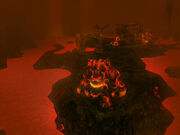
Subsequent levels in the 100's take truly extreme amounts of effort. If a player cleared the Elite-mode Volcanic Caverns three times daily, it would take four thousand years to become a Grand High Siegemaster (150 in all four disciplines). But it is unclear whether the game can actually track experience gains for high-level characters properly. A Level 146 character, whose experience totals are only saved in increments of 10 billion, might not get any experience at all for fighting unmodded monsters.
Top Locations for Levels and Treasure[]
Dungeon Siege is more about the journey than the powergaming, but some parts of the Peninsula commend themselves to the munchkin in every human heart.
- Players leaving south from Crystwind will rub against a far more advanced section of the main quest path. The foes here are level 35 to 40; nevertheless, attacking them with a level 3-7 hero seems to be a popular pasttime. See the Skeleton Ranger article for tactics.
- With sufficient xp gains and choice spells, it is possible to press further into the Lang/Quillrabe road. Turning north towards the Fury Den, the direction of Lang, offers the prospect of some rare drops if you can kill the Furies.
- The Volcanic Caverns are accessible to especially-determined low level players. The Lost Pyramid of the Dead drops the player down in proximity to creatures that are somewhat manageable with good kiting. Even marginal success in the volcanic caverns will leave the player more-than-prepared for the stuff in the rest of the Peninsula.
- Extra on-the-spot leveling, and drops, may be earned when the party encounters Ice Mages and Swamp Witches. These foes summon monsters. Just leave the summoner alone and attack the monsters.
- Secret areas in the Mount Utrae Temple beyond Fallraen have high-level chests.
- The most popular, profitable site for higher level players is the dungeon adjacent to Grescal, the Abandoned Ruins. The multiplayer bookmark for the town is leveled 50/80/106. Frequently called a "Grescal chest run," it makes for a quick and densely-packed session. The dungeon has four gilded chests of the same calibre as the ones in Ehb's Chamber of Stars.
- Castle Hiroth, the Utraean dungeon beneath the town, the Grescal environs, and the Volcanic Caverns are the richest sources of experience on the Peninsula. The loot at the end of the Utraean dungeon, which concludes The Utraean Circle (Quest), is bad.
- The Chicken Level (see that page for details on accessing and surviving in the dungeon) is a paltry source of experience, but is far-and-away the game's best source of treasure.
Sites outside the Peninsula:
- In Ehb, the hideouts of the Rogue Bandit, the Bandit Boss, and The Lost Witch contain rares and uniques, and they are clustered close together. Start from the multiplayer bookmark Traveler Camp (Level 17) and proceed south through the Dark Forest.
- Running the endgame content in Ehb from the multiplayer bookmark, Castle Dungeon (Level 46), is a dense leveling opportunity, since the chapter was designed for a party of eight. Unfortunately the bookmark starts the player just past the King with the way backwards sealed. This means the player is unable to pick up the key to a profitable detour, the Chamber of Stars. Gom himself may drop fewer, but higher-rated, equipment than the CoS chests. Exp in the Vault of Eternity is of the same scale as the Volcanic Caverns, though the region is shorter.
- Reaching Cicatrix on the Aranna map and his super chest cluster: hug the left (south) boundary of the swamp past the Trader Camp (Level 11/62/90 multiplayer bookmark), and there is a plunder-able sarcophagus guarded by unique Wraiths. Further along the boundary is the entrance to the necromancer's mountain. A hero with the "Lair of Cicatrix" quest completed can take the lift directly from the Trader Camp to behind his throne area.
- The Great Clock at the end of Aranna has so-called "elemental" chests with good finds, particularly in the form of rings and amulets. It is also worthwhile to obtain the Veteran and Elite versions of the Staff of Stars. There are a couple of difficulties with this run. The creatures there only scale up to about a quarter the xp of the Peninsula's top creatures, so it is mainly just a dash for the chests; the place is also a long journey past the final bookmark, Neener's Emporium (Level 24/70/99), and the direct lift from Arhok to the Clock is useless, because it merely arrives at a locked door.
- The absolute highest pcontent (the word for random treasure rolls in DS) comes from multiplayer-only chests that replace the green Set Item chests on Aranna on the Veteran and Elite modes. The chests are dispersed throughout the island, such that hunting them would be considered nothing less than a playthrough of the full LoA campaign.
| Set Chest Locations | |
|---|---|
| Arhok's Leather | Cellar beneath the hero's house, in Arhok. Can be retrieved right away. |
| Arhok's Short Bow | Halls of the Lost Queen, the first left after the cave entry from the snow. |
| Illicor's Ring | Halls of the Lost Queen, revealed by hidden switches in a room with a document on the floor called "The Account of Ashish." |
| Arhok's Shield | The coastal bluffs before Illicor, in a sea cave just past the site of the cutscene with Nosirrom and the Shadowjumper. |
| Illicor's Amulet | Dark Jungle not far beyond Illicor, when there is a T-intersection where the torch-lined main path goes left and up, stay right for an extended detour. |
| Arhok's Long Sword | Therg's dig site, down the stairs from the lift and on the right in a room marked "Meditation Chamber." |
| Kajj's Breastplate | Within Death Mountain, at the entrance to its deep volcanic cavern-complex from the dungeons. |
| Illicor's Beaded Hauberk | After Death Mountain but still in the swamp-zone, beside the flight of stairs exiting the region. |
| Kajj's Gauntlets | Jherkal's Crown jungle ruins, towards the beginning, in the middle of the largest ziggurat. |
| Illicor's Staff | On a small, two-story ziggurat in the Jherkal's Crown jungle ruins, past the large initial complex. |
| Solov's Ward | Jherkal's Crown jungle, in a pot at the bottom of a deep, water-logged sink hole. |
| Solov's Bow | Stay left in Jherkal's transportation center to reach a lift down to the jail pens; it's in one of the cells. |
| Solov's Spellbook | Demlock's Cut, in an urn hidden behind a waterfall very close to the NPC Bran Torath. |
| Demlock's Spellbook | In Demlock's Cut - Given by Lhuk Torath for completing the quest, "The Horror of the Rune Master". |
| Kajj's Helm | Demlock's Cut - keep right in the long ravine beyond the merchant Lhuk Torath. |
| Illicor's Spellbook | Kmethket's Tower, in the room prior to the Doppleganger Boss and displacer platform. |
| Demlock's Amulet | Xot's Badlands along the region's winding, central river. |
| Claws of Kajj | Detour prior to the cliff settlement of Xulphae's Cove, up the cliffs on a broken bridge. |
| Clockwork Boots | Crystal tunnels, at the Healing Spring being sought by the Utraean pilgrims. |
| Demlock's Ring | Tunnels before Fortress Emarard interior, just before the Fury. |
| Clockwork Amulet | In a room adjacent to the volcanic cave exit at the end of Fortress Emarard. |
| Clockwork Staff | Beside the displacer leading to Mount Kreth from the volcanic cave. |
| Clockwork Crossbow | In the goblin complex, in a large room with a depression and two giant gears set in the floor. |
Multiplayer Scaling[]
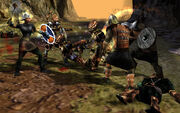
In multiplayer, the hitpoint and xp ratings, but not attack or defense, of monsters will be adjusted with the number of clients connected, according to the table below:
| Clients | hp | xp |
|---|---|---|
| 1 | 0.35 | 0.35 |
| 2 | 0.5 | 0.59 |
| 3 | 0.8 | 0.8 |
| 4 | 1 | 1 |
| 5 | 2.15 | 1.25 |
| 6 | 3.1 | 1.5 |
| 7 | 4.17 | 1.75 |
| 8 | 5 | 2 |
- In single player
- Regardless of how many party members are deployed the health and experience values of monsters will always be multiplied by 1, which is unlikely to change them much.
Difficulty Setting[]
Difficulty applies a multiple to damage dealt by players and monsters.
Setting the game's difficulty to Easy can be good when playing with kids. Setting it to Hard can be good when playing with in-laws, or to otherwise add realism to battles.
| Setting | Players | Monsters |
|---|---|---|
| Easy | 1.35 | .5 |
| Medium | 1 | 1 |
| Hard | .85 | 1.45 |
Each hitpoint on each monster yields the same experience value, so the total experience available in an Easy world and a Hard world is the same. But because the player deals only 85% damage on the hard setting, the player simply makes slower progress through the hard world in travelling and leveling up.
On the other hand, weapons dropped from enemies on the hard setting always sell for 2/3 of their base value. Weapons dropped on the easier settings are marked-down more severely and non-linearly with respect to their base value.
Experience for Damage-over-time (DoT)[]
Tests reveal that spells and martial weapons carrying DoT effects award experience differently from instantaneous damage. Examples of Damage-over-time attacks:
- Melee and Ranged weapons that proc Poison and Acid damage (see Prefixes)
- Captured Goblin weapons like the Flamethrower and Dragon Minigun
- Most Combat-aligned fire and all acid spells
- Some Nature-aligned light spells
Examples of Instant damage:
- Melee weapon swings
- Shots from bows and crossbows
- Fireshot
- Zap
When lower-leveled players use DoT attacks against higher-leveled enemies, their experience gains are massive. But high-leveled players get more experience when dealing instant damage against the same enemies.
- To gain maximum xp at low levels, use DoT.
- To gain maximum xp at high levels, use instant damage.
Testing has uncovered some possible reasons for this. There are ceiling values for exp gains defined in formulas.gas; these "experience-limiting factors" may not matter for a high-level character, whereas for a low level character they will cap the amount of xp gained from a hit:
[experience_limiting_factors] {
first_level = 0.10;
later_levels = 0.025;
}
Continuous damage, computed frame-by-frame, may pass below these ceilings when a low-level character deals it.
After a certain point there is no weapon powerful enough, and no monster xp-rich enough, that could give a high-level character .025 levels in a single hit. Meanwhile, characters' xp point totals eventually get stored with scientific notation, and it may be that big instant hits more accurately tally experience gains than tiny DoT increments.
Experience for reflecting damage[]
The series of of Reversal item suffixes can reflect hand-to-hand damage back at the attacker. A couple of spells do it, too. The effect does not function against ranged and magic attacks. When damage is reflected back at a foe, the player gains experience in whatever weapon or spell class he has readied, despite only reflecting hand-to-hand attacks.
The spells are:
- Shared Pain: Nature 50-70, duration 30–42 seconds, magnitude 50% damage reflection.
- Pain Reflux: Combat 38-58, duration 61–92 seconds, magnitude 30% damage reflection.
Experience for retaliation spells[]
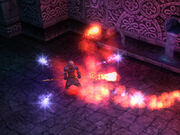
A DoT effect like drake fire tends to trigger all of a character's retaliation effects at once (pictured: Multi-Spark, Firebomb, Firespray).
LoA introduced a series of magic armor suffixes that will randomly fire spells in retaliation for getting hit. This effect is triggered by all forms of attack, not just hand-to-hand like reflection. The spells are:
- Zap
- Fireshot
- Spark
- Firespray
- Fireskull
- Lightning
- Fireball
- Multi-Spark
- Lightning Blast
- Light Ray
- Starburst
- Firebomb
- Nova Strike
The magnitudes represent an ascending probability of the spell getting fired, as follows:
- of Lesser Zap - 10%
- of Minor Zap - 15%
- of Zap - 20%
- of Major Zap - 25%
- of Greater Zap - 30%
Damage dealt by these random spells will award xp to whatever weapon or spell class the player has readied; i.e., a triggered Firebomb awards xp to Nature skill if the player has Major Heal activated for casting.
Casting reload delays[]
Spells are given reload delays. Most are 1 second. Players might observe the difference in firing rates between Zap and Fireshot early on; Zap's reload delay is just 0.15 seconds.
Other spells have been "rebalanced" with long reloading delays, pursuant to the designers' often-dubious judgment in such matters. In most cases the lengthened delay puts the spellcaster entirely out of commission for that period. He cannot cast anything. So make sure the spell was worth it.
Some delays are understandable, as in the case of Cyclone of Fire (3s) which can deal huge damage and is fairly graphics intensive, or Meteor / Meteor Storm (5s) which are extremely graphics intensive.
Other instances of this mechanic reduce bad spells to laughable spells, as is the case with Storm and Lightning Storm (10s delay).
Weak or Non-Factors[]
Quests[]
Completing certain quests in the game may trigger a scripted experience reward. The xp is assigned to the weapon or spell currently equipped. Most players remain completely unaware of this feature of Dungeon Siege, because the rewards in the default campaign settings are too inconsequential to notice.
User-created maps can, at the creator's discretion, generate big experience rewards using the existing conversational script components.
Casting Spells[]
Dealing damage is the main way to gain experience. The developers thought they would balance non-damaging spells and hexes, however, by awarding experience for casting such spells. Unfortunately these gains rapidly become trivial. Throwing a maximum-strength Major Heal spell awards 344 xp. Killing a Seck Grunt yields 82,000 xp.
This has an important implication. Hexes and support spells are useful, but players should allow spellcasters to spend most of their time throwing direct-damage attacks at the enemy. Otherwise, they will fall behind the team.
Destroying Containers[]
Containers are interactive objects with loot in them, like urns and barrels. The player may gain the aforementioned smidgeons of xp for casting spells at them, but will not gain xp for destroying the container.
Martial Weapon Recommendations[]
Melee and Ranged fighters have the relatively simple mandate of obtaining the best weapon they can find and using it. There are very few other concerns; these can be described in brief.
One-Handed Weapons[]
Legends of Aranna introduced a dps measurement on the tooltips for weapons and spells. Since xp is given for damage dealt, there is no difference in xp gained between 1-handers and 2-handers with the same dps. However, 1-handers allow the use of a shield.
Any character can carry a shield and gain the benefits of magical properties it conveys, but only melee fighters wielding 1-handers can make use of the highly desirable base properties of the shield, the ones written in white. Shields offer good inherent defense ratings and hard block rates against non-magic attacks.
DoT[]
As mentioned earlier, weapons can carry enchantment loads that inflict damage-over-time effects. Goblin guns do this normally. Again, damage over time can be a great way to train if the character's experience is especially low or the enemy's is especially high. In the endgame, it is better to rely on instantaneous damage, which the vast majority of martial weapons do.
Armor Piercing[]
An armor-piercing hit ignores the target's armor and deals exactly the damage given on the weapon or spell's tooltip.
Seeking out sources of armor-piercing is recommended. The harder the enemy, the stronger this mechanic gets.
- Sources of Armor Piercing
The only spells observed to ignore armor are Leech Life, Zorkon's Bonecrusher, and the Glpyh spells.
There are blue and purple mods that add a %Chance to inflict piercing hits, and ones that add straight integer piercing damage to attacks. Each one is limited to either Melee or Ranged.
- Main article: Prefix List (Dungeon Siege)
- Main article: Suffix List (Dungeon Siege)
Rune Series and Guiseppi's Wares are multiplayer-only sets that have high armor penetration, but the useful lifespans of their weapons are not very long.
The best source of armor piercing, at 50 percent, is the easter egg reward for completing Legends of Aranna, the Mac Daddy Cap. This hat affects both Melee and Ranged. It increases a character's attack power enormously.
Offensive Spells[]
Nature mages need a Zap spell to begin training, and Combat mages need Fireshot. This section will cover various attack spells of interest as the character levels up.
There are some important things to bear in mind about attack spells that go beyond the in-game descriptions on the scrolls.
- The damage ratings written on the scrolls are for one projectile only. Some spells are like shotguns that send out lots of pellets at once, and even accounting for the randomized innacuracy of these pellets, their effective damage could be several times higher than the listed damage.
- Some spells appear to deal a ton of damage quickly, but can prove impractical in some way, like having a too-high cost, tiny range, or a slow or wierdly-shaped trajectory. Keep tried-and-true spells onhand when testing new ones.
- Spells with a mana cost dependent on the target are almost never any good. It is virtually always more efficient to simply buff allies and kill enemies.
Best-of-breed[]
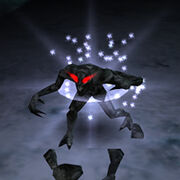
Flash
These are 1) easy-to-use, 2) deal average-or-better damage, and 3) have reasonable casting costs.
They go obsolete as the game progresses. In the level gaps between these spells, there is a dearth of satisfactory replacements that fulfill all three criteria.
- Flash
- Nature 3-21
- Flash deals a large packet of fast DoT, which can maximize experience gains, in a small radius centered on the target. It takes effect instantly on the target, never missing or being obstructed. It is powerful against monsters that are closing in on top of each other. Its drawbacks are that it has a short range (6m) and is expensive.
- Iceblast
- Nature 24-52
- Icefury
- Nature 54-78
- These are shotgun-type spells, shooting multiple projectiles at a reasonably high velocity. The tooltip shows the damage per projectile, meaning the total damage potential compares very favorably, indeed, with other entries in the nature repertoire. They are effective at long range but most accurate up close or against large creatures.
- Explosive Powder
- Combat 3-25
- This spell's "pineapple" bounces along the floor, per physics. This gives the spell extraordinary range when shot at the ground. The explosion is AoE and DoT. Other combat attacks may tempt people as they become available on the way to lv20, but they simply lack the utility of Explosive Powder. Soul Lance for instance does far more damage but is a very slow, short-ranged nuisance with no explosion radius. Fireskull is much cheaper for the same amount of damage, nominally, but there is a delay between the cast and the shot, and it has neither AoE nor physics.
- Fireball
- Combat 20-47
- Fireball is a very cheap AoE spell that far surpasses Explosive Powder in radius and magnitude. It is still prudent to leave Powder in the spellbook for long-range pulling.
- Bomb
- Combat 60-90
- Bomb shoots a physics pineapple with a greatly-increased blast radius over Powder, with damage scaled properly for high-level combat. Bomb drinks mana. Keep Fireball in the spellbook for a while even after reaching 60, so that you can keep attacking whenever this is an issue.
A mage should spend most of the campaigns with one of these spells loaded. After level 78 a Nature Mage has little recourse but to continue to use Icefury, which consistently outperforms everything else in the Nature repertoire. Nature users who are willing to look and sound stupid while to blowing through everything with ease can supplement with LoA's Chicken Orb.
At level 96, Combat gets access to Cluster Bomb, which is inaccurate and expensive, but powerful. The Zorkon spells described later are also useful Combat attacks in the correct contexts.
Training spells[]
Both of the magic schools have support spells that are useful to other classes. The DoT spells are good for cross-class training, because of the odd behavior of DoT when it comes to giving experience.
- Dancing Zap: Nature 6-26
- Shock: Nature 8-37
- Acid Glyph: Combat 2-22
- Acid Gas: Combat 1-20 (if no access to LoA)
They have exceptional experience yields when the skill is very low level and the monster is very high level.
Zorkon[]
Legends of Aranna introduced three Combat spells with unique offensive effects.
- Zorkon's Bonecrusher: Combat 17-37
- Zorkon's Disintegrator: Combat 25-65
- Zorkon's Exploder: Combat 75-150
Bonecrusher deals the damage given on its tooltip and is armor-piercing. But against Skeletons and a limited number of skeleton-like foes in LoA, the damage is multiplied by 18. Contrary to the tooltip, it does not get more expensive based on the power of the target. At the level cap, it strikes skeletons for about 900 damage (50 otherwise) and costs 27 mana against any foe, making it bar-none one of the most efficient attacks in the game.
Disintegrator kills the target. Mana cost goes down (and efficiency up) linearly from 2× the target's life at Combat 25 to 1× the target's life at 65 or greater. This spell is especially efficient against high-armor foes, as the casting cost disregards armor, and is extremely fast, if the caster can afford it.
Exploder is not recommended. Its casting cost scales in the same, linear fashion as Disintegrator, but as opposed to 65, it is not fully efficient until level 150. The area-of-effect explosion it generates is not necessarily worth the higher cost.
Grenades[]
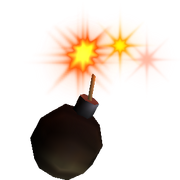
Three Combat spells produce a grenade-like object referred to in the data files as a "pineapple." These projectiles are fast, fun, and and can exceed their casting range by bouncing along the ground. As discussed earlier, the grenade spells are candidates for being a Combat mage's primary attack during their effective lifespans. Their damage ratings start very high but do not scale well beyond a few levels, but their ease-of-use never goes away.
These entries do not count as fire spells, an unfortunate drawback for them in LoA, where the player has access to spellbooks that can improve fire-type spells.
- Explosive Powder: Combat 3-25
- Bomb: Combat 60-90
- Cluster Bomb: Combat 96-120
The casting range (white circle) and physical range of cluster bomb is pictured below. Explosive Powder and Bomb only fire one projectile, but it is more accurate.
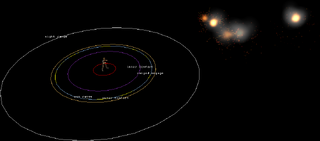
Poor-logistics spells[]
The aforementioned grenades have utility. As a counterpoint, here are examples of attack spells that are painful to enemies but can also be a pain to the player, for various reasons.
- Spark: Nature 4-24
- Multi-Spark: Nature 30-66
The homing projectile sparks move very slow and will collide harmlessly with walls, doorways, stalagmites, etc. At point blank range, the sparks move beyond the target to see if there are any obstructions to colide with first before heading back for the target.
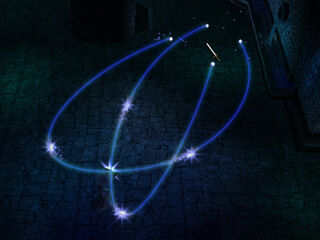
- Firebomb: Combat 70-90 - This spell deals 10 percent more damage than Bomb. But the projectile is very slow and its high, strange firing arc becomes a nuisance.
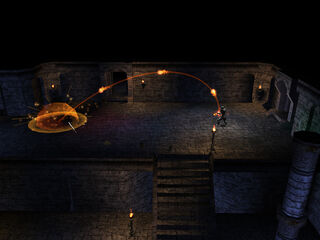
- Fire Wall: Combat 32-77
- Pillar of Fire: Combat 72-88
- Cyclone of Fire: Combat 90-120
Firewall costs too much for practical use. But its more advanced applications, Pillar and Cyclone, conjure wandering columns of flame. They deal so much damage that the player may wish to adjust tactics to accomodate their use. Enemies need to be tied-down, ideally stationary in the spot targeted by the spell, for the flame columns to build momentum; once there are several columns of flame moving through a pack of foes, they will quickly get cooked.
Pillar makes a slow loop, passing through the target location twice, as shown:
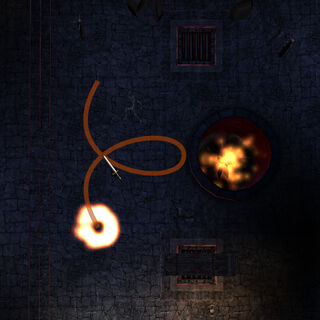
Cyclone moves more quickly and endures longer, making 2 full laps along this cloverleaf pattern and passing through the target location 8 times:
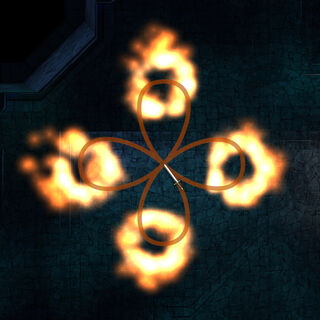
- Lightning Bolt: Nature 84-116
Probably the most difficult spell of all to pull off, this is a unique, turret-like spell, where the caster conjures a huge charge over his head that starts owning everything in sight, and quickly.
The problem with this arrangement is that the caster cannot move or be struck— not by anything— or the charge will terminate. The caster will need skilled (or carefully microed) comrades to draw enemies in range of the spell and keep them occupied. There does not appear to be any easy way to bring this spell to its full potential. It spell breaks Invisibility, and getting hit while Invincible still counts as getting hit.
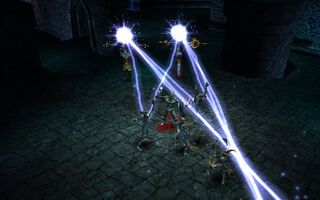
Orbs[]
Orbs are long-lasting enchantments introduced in LoA that throw projectiles passively.
- Orb of Fire: Combat 2-25, max. 144 dp10s
- Orb of Frost: Nature 4-21, max. 146 dp10s
- Orb of Acid: Combat 12-33, max. 199 dp10s
- Orb of Lightning: Nature 13-33, max 221 dp10s
- Orb of Healing: Nature 10-35, max. 167 hp10s
- Orb of Energy: Combat 37-72, max. 510 dp10s
- Bubberjack's Orb of Poultry: Nature 0-155, max. 13,676 dp10s
These low-hassle spells can be substantive during their effective level ranges. The Healing Orb can be useful in the way it does not always target the topmost partymember-in-need on the roster (a character set to autopilot healing will do this).
Orbs of lightning and energy cannot miss, as they fire a beam that directly connects with enemies.
The easter egg spell Orb of Poultry, a gift from the Disco Krug, is in a league of its own. It's a joke spell, but at the price of looking and sounding ridiculous, a Nature mage can just about quadruple his overall damage output with this spell. The spell has a very long duration. Its strength is set at the time it was cast, so do not stack the duration if you are anticpating level-ups.
Glyphs[]
The stronger glyphs are no good for routine use, because they do not give experience. It is still a good idea to keep a Glyph in the spellbook as an emergency kill switch. They are, in fact, the best all-around skills in Dungeon Siege for clearing whole rooms, caverns, and fields of enemies at once. If they gave experience properly, they would all be in the "best-of-breed" section above.
These spells come in several varieties for both Combat and Nature. The caster conjures a limited-duration proximity mine on the floor that will detonate when enemies draw near. The glyph can be cast directly at or near an enemy, and it will trigger immediately in that case.
- Acid Glyph: Combat 2-22
- Zapper Glyph: Nature 7-27
- Flaming Glyph: Combat 9-31
- Detonating Glyph: Combat 21-46
- Shockwave Glyph: Nature 22-42
Glyphs exhibit some erratic behaviors.
- All Glyphs except Acid ignore the enemy's armor rating, so they deal exactly their displayed damage.
- All except Acid have an effect radius of 10 meters, just about the largest AoE in the game.
- The Flaming and Acid Glyphs inflict DoT and give experience. The others do not.
- Apparently as a side-effect of the Glyphs' damage not getting credited properly to the caster, the caster can sustain Respite and Invisibility while battering foes with them.
Glyphs are ideal for picking up the pieces from a full party wipe. Everything dies, and party members can be resurrected safely. They are also a phenomenal weapon against Chickens, because these creatures are a trivial source of xp anyway, and they have huge armor ratings which the Glyphs ignore.
Support Spells[]
Healing[]
- Healing Hands: Nature 0-39, efficiency ≈3
- Battle Healing: Combat 10-99, efficiency ≈2
- Major Heal: Nature 32-111, efficiency ≈4
Single-target heals are important in solo and parties.
At about 2 hp per mana spent, Battle Healing is less efficient than the two Nature spells. Major Heal is probably the best, if basic, support spell in the game, and becomes available before Healing Hands reaches its magnitude cap at 39.
Regen[]
- Healing Wind: Nature 9-46
- Reconstitution: Combat 24-84
- Nurture: Nature 46-111
These cover the whole party with a short-lived "healing breeze" effect. The magnitude of Healing Wind is abnormal, frequently healing several times the amount given on the tooltip.
These spells are especially powerful in combination with "life-balancing" enchantments should the party get access to them. Damage is divided among the party members, and then each one receives the full effect of these heals.
- Mana Chant: Combat 9-22
- Regeneration: Nature 18-44
- Party Recharge: Nature 58-78
Mana Chant increases the caster's mana regeneration rate. Regeneration increases the target player's health regeneration rate. Mana Chant is phenomenally useful, while Regeneration is easy to duplicate elsewhere.
Party Recharge is an expensive, high-level spell. It provides health and mana regen to all party members in the area, who all simultaneously receive the duration-stackable buff, "Recharge Boost." Because this is a separate state from Mana Chant, the two spells can function together.
Reconstitution / Battle Healing Glitch[]
There is a scripting glitch when using these two spells if they are thrown by two or more characters simultaneously (i.e. following orders given during pause). When the spells take effect, there will be a few frames of near-infinitely-fast regeneration on any character with both effects at once. If the party is high-enough level to use Life Balance, the love will be spread to every party member.
Balancing[]
- Share Damage: Combat 15-35
- Mana Balance: Nature 46-66
- Life Balance: Nature 66-86
- Harmony: Nature 80-105
These are only for use in parties obviously. They have the effect of distributing wear-and-tear evenly around all the members. It's hard to overstate how much this can improve your performance in battle. It takes a lot of pressure to kill the whole party at once. No single party member can get taken out by concentrated attacks, and the stock in wide-area spells like Healing Wind soars.
- Share Damage
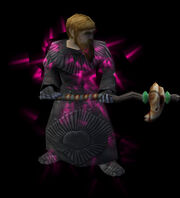
Share Damage vfx
- Share Damage is what players have to work with first. This spell is expensive and has a short duration that cannot be stacked. It has to be recast every 15 to 45 seconds as per the mage's skill level; party members in range all simultaneously get their own instance of the buff, and they are made immune to further castings of the spell until the duration runs out. This means the spell's expiration event needs to be vigilantly monitored during a fight.
- On the plus side, the effect is somewhat more powerful than Life Balance. When a buffed party member is attacked, the damage packet is calculated based on that party member's Armor Rating, but before being applied at all, it is redistributed to all members with the buff in proportion to their current hitpoint totals. This prevents any one member of the party from collapsing; only when someone sustains a hit that exceeds everyone's life is there a real problem (whereby everyone keels over at once).
- Share Damage also counts as an attack on every party member with the buff; it triggers the Retaliatory spell mods on all the party members as well as Damage reflection if the attacker is using hand-to-hand.
- Balancing
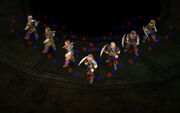
Life and mana-balancing vfx
- Life Balance, Mana Balance, and Harmony are high-level Nature spells. The balancing effect works a little differently from Share Damage. With these, damage is confined to the party member that takes it, and the party's health is rebalanced immediately after the hit is sustained. Anyone who is unconscious or dead is instantly resurrected— so there is no longer much need for revive spells— as long as there is aggregate health to spare. This post-fact rebalancing does not trigger retaliatory mods like Share Damage does.
- There is a hidden danger with this different behavior, which is when a party member takes enough trauma that would render him unconscious. While Share Damage prevents the victim from going unconscious, Life Balance does not, and he actually does go unconscious for an instant and does the falling-down animation. The entire rest of the party's health is depleted by a penalty needed to revive him. If he is being constantly attacked, this starts happening over and over again, massively draining the party. Bottom line: keep hp's reasonably high while using Life Balance to avoid someone falling unconscious, and be ready to retreat if swarmed (like you should do anyway... this spell is tactical- it does not make up for bad strategy).
- Balance and Harmony put an enchantment on one party member, rather than taking effect on all members as with Share Damage. The enchanted party member radiates an aura conveying the spell's benefit to the other party members in the frustum (128m) without putting them in an enchanted state. The enchantments are long-lasting and stackable. Life Balance and Mana Balance are mutually exclusive if cast on one person, so don't do that.
- Harmony simply combines the Life and Mana Balances into one spell, saving room in the spellbook and time on the player's part, but is not otherwise different.
Triple Strike[]
- Triple Strike: Combat 22-54
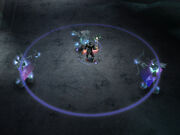
The halo shows the area around an adventurer in which enemies can be affected by Triple Strike.
Triple Strike causes a character's melee swings to hit two additional targets in the area, tripling damage dealt. It is popular for experienced fighters to push Combat to 22 specifically to gain the ability to use this spell. The duration of the effect is always 20 seconds, though it can be multi-cast. Gaining levels beyond 22 does nothing but raise the casting cost of the spell by an additional 11.25 per level, from 250 to a max of 610.
Death Blast[]
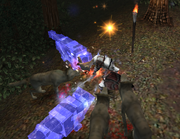
These black wolves have been affected by both proc effects present on this adventurer's sword (stoning and freezing), delivered via the death blast of a packmate.
- Death Blast: Combat 24-39
Death Blast is another spell that can greatly benefit melee fighters, and has some interesting effects on top of its useful base power. Its normal effect is that enemies killed by whoever the spell is active on will explode in a burst whose area-of-effect damages other enemies nearby. Some interesting things about Death Blast are as follows:
- It carries over weapon enchantments through its AoE blast, and proc effects are triggered on every enemy within range.
- On Veteran difficulty or higher, on the Isle of Utrae theater in the expansion, some enemies killed while Death Blast is active will drop items that they normally shouldn't. This is due to the blast deleting enemies rather than killing them, and an associated glitch. Normally, when enemies are killed, their inventories are kept. However, Death Blast bypasses this by deleting enemies. For the inventory to be deleted would cause a memory leak, so the compromise to avoid this is for the Death Blasted enemy to drop its inventory.
- Deletion occurs after the target reaches zero hit points, so experience is kept.
- It can be buddy-cast.
Untargetability[]
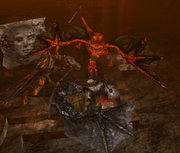
One can end up stuck in some rather frightening and lethal situations...
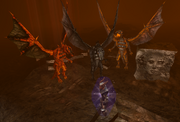
...but given enough mana, Respite can be there to save you.
There are three spells that render player characters unable to be targeted by new attacks, precious time which can be used to heal or cast support spells. Nature magic has access to Respite, and combat magic has access to Invisibility and Targeted Invisibility.
- Respite: Nature 7-27
Respite is a nifty way for nature mages to get out of hairy situations; it provides up to a full minute of immunity to being specifically targeted by new enemy attacks. Furthering its utility is the fact that it can be cast during the damage-dealing phase of a melee attack animation while the game is paused, leading to an instant cast in real time.
However, in-progress attacks will still deal damage, though sustained attacks may cut short. Additionally, enemies can still see you, even if they cannot attack.
Respite cannot be multi-cast.
- Invisibility: Combat 10-30
Invisibility is the combat mage's equivalent to Respite. Its starting duration is shorter, but, unlike Respite, it is able to be multi-cast.
- Targeted Invisibility: Combat 21-46
Targeted Invisibility confers the boon of untargetability unto allied party members.
Shield spells[]
These are spells that, by default, give a passive armor bonus. Later spells can also cause damage to enemies who attack.
- Magic Armor: Nature 3-91
- Stone Skin: Nature 8-111
- Spirit Armor: Combat 12-78
- Flame Shield: Combat 32-102
- This spell is unusual in a few regards: can only be single-cast, it forms a defensive perimeter rather than a form-fitting shell, and most strangely, it functions even while the user is dead or a ghost.
- Shock Armor: Nature 34-87
- Frigid Armor: Nature 50-98
- Fireshot Armor: Combat 63-93
Using Summons[]
Leveled list, Nature[]
- Giant Rat (LoA): lv 4-25, Melee, 360s, +67 Def, 363 mana @ lv 25
- Killer Gremal: lv 7-37, Melee, 360s, +99 Def, 531 mana
- Cave Bear (LoA): lv 11-23, Melee, 240s, +62 Def, 335 mana
- Chomper (LoA): lv 14-34, Melee, 120s, +382 Def, 524 mana
- Scorpion: lv 15-35, Melee, 120s, +393 Def, 539 mana
- Barkrunner (LoA): lv 19-40, Melee, 240s, +280 Def, 614 mana
- Furok: lv 22-42, Melee, 120s, +294 Def, 644 mana
- Zepheryl (LoA): lv 23-50, Ranged, 360s, +211 Def, 866 mana
- Dark Zepheryl (LoA): lv 26-55, Ranged, 240s, +232 Def, 951 mana
- Cave Giant: lv 30-50, Melee, 120s, +229 Def, 764 mana
- Forest Klaw: lv 35-55, Melee, 240s, +386 Def, 895 mana
- Scrub Howler (LoA): lv 37-62, Melee, 120s, +435 Def, 1007 mana
- Black Wolf: lv 40-60, Melee, 360s, +383 Def, 853 mana
- Spiked Dweller: lv 48-68, Ranged, 360s, +550 Def, 965 mana
- Larch: lv 60-80, Melee, 240s, +1008 Def, 1214 mana
- Troll Masher (LoA): lv 73-93, Melee, 120s, +652 Def, 1597 mana
- Green Drake: lv 86-106, Combo, 120s, +1163 Def, 1818 mana
- Frost Golem: lv 95-112, Melee, 240s, +786 Def, 1694 mana
- Rock Beast: lv 105-112, Combo, 120s, +1431 Def, 1920 mana
Leveled list, Combat[]
- Jade Gargoyle: lv 5-26, Ranged, 360s, +93 Def, 377 mana @ lv 26
- Twisted Mucosa (LoA): lv 8-30, Melee, 360s, +108 Def, 433 mana
- Vile Twisted Mucosa (LoA): lv 10-35, Melee, 240s, +393 Def, 539 mana
- Skeleton: lv 10-30, Melee, 240s, +337 Def, 464 mana
- Mucosa: lv 16-36, Melee, 120s, +184 Def, 591 mana
- Death Knight (LoA): lv 20-45, Melee, 360s, +230 Def, 735 mana
- Darkling: lv 21-41, Ranged, 240s, +173 Def, 713 mana
- Ursae (LoA): lv 25-50, Melee, 300s, +207 Def, 713 mana
- Skick: lv 28-48, Melee, 120s, +371 Def, 832 mana
- Forest Troll: lv 33-53, Melee, 240s, +271 Def, 809 mana
- Deadly Armor (LoA): lv 36-56, Melee, 240s, +287 Def, 854 mana
- Hell Boar: lv 39-59, Melee, 360s, +467 Def, 899 mana
- Zombie: lv 43-63, Melee, 300s, +260 Def, 895 mana
- Picker: lv 48-68, Melee, 240s, +544 Def, 1034 mana
- Fleshrender (LoA): lv 51-81, Melee, 120s, +648 Def, 1229 mana
- Wraith: lv 53-73, Melee, 240s, +617 Def, 1109 mana
- Wraith Archer: lv 57-77, Ranged, 360s, +748 Def, 1091 mana
- Skeleton Krug Dog: lv 61-81, Melee, 360s, +546 Def, 1065 mana
- Rune Guardian (LoA): lv 65-95, Melee, 240s, +641 Def, 1247 mana
- Desert Braak: lv 69-89, Ranged, 240s, +680 Def, 1439 mana
- Impaler: lv 75-95, Melee, 120s, +897 Def, 1535 mana
- Mucosa Predator: lv 80-100, Ranged, 120s, +1008 Def, 1716 mana
- Slithermage (LoA): lv 83-111, Ranged, 120s, +1118 Def, 1903 mana
- Lava Spirit: lv 86-106, Ranged, 240s, +1144 Def, 1711 mana
- Black Drake: lv 94-112, Combo, 120s, +1088 Def, 1920 mana
- Slag: lv 100-112, Melee, 240s, +1753 Def, 1694 mana
- Rock Golem: lv 100-112, Melee, 240s, +1209 Def, 1694 mana
- Fire Elemental: lv 105-112, Melee, 240s, +756 Def, 1694 mana
Stat summary[]
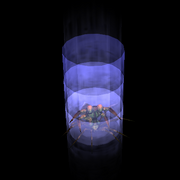
Summons inherit attributes and skill levels from the normal-world, 1W version of the "evil-side" monster they are based on, and from the Combat or Nature Skill level of the caster. The aid from the caster's skill gets frozen at the max level of the spell; e.g., 26 for the gargoyle.
In particular therefore, the creature's armor and ability to penetrate enemy armor go fantastically obsolete eventually, so keep your spellbook up-to-date.
The summoner's Skill level affects the following on the creature:
- STR
- DEX
- INT
- Melee
- Ranged
- Combat Magic - All monsters' spells are treated as cmag. Yes, a summoner's nmag will boost a nature-aligned creature's cmag Skill, and the creature's attacks will train the summoner's nmag.
- Armor Rating
- Health
- Mana - This is not used by the creature.
- +Min and +Max damage - In melee, ranged, and cmag, as applicable.
All damage dealt by the minion is credited to the caster as either Combat or Nature training depending on the school of the summoning spell, and regardless of what weapon the caster has readied meanwhile.
Recommendations[]
Since summons are expensive, try to position for a fight in a way that predicts the actors' behavior. Monsters sometimes switch focus to prioritize close targets, so the melee-bound creatures usually serve as meat shields. Their tendency to charge forward may draw more foes in, which is troublesome. The ranged summons can serve more steadily as damage turrets from the back line. Neither melee nor ranged summons exhibit any retreat behavior, so if you retreat under pressure, consider the summon lost.
Summons can be healed by both the single-target and party-wide healing spells, but it has to be done manually. Characters set to autopilot healing will ignore their plight. The Orb of Healing does not ignore them, though.
Grenade spells can be especially handy for drawing a trickle of customers in and pounding them with your summoned creature's help. Some of the summons are rather slow creatures. This makes them bad for a party working fast, but just fine as meat shields in a hard battle.
Summon Clone[]
- Summon Clone (LoA): Combat 15-65, 120s
This is an especially powerful type of summon. The maximum level of the spell merely caps the casting cost, while the clone gets the caster's full statistical profile. All damage dealt by the clone trains the caster's Combat Magic.
The weapon selection hierarchy for the clone is as follows:
- If the caster's active weapon(s) cannot be determined, the clone defaults to karate. This usually happens after visiting a merchant. Picking up and replacing the spellbook usually fixes this.
- If an offensive spell is in the player's alternate spell slot (the one without Summon Clone), the clone will use that to attack. The clone has a mana pool with the attributes of the caster. All spells have little "usage context" and targetting flags in their templates that tell the AI how to use them, and valid offensive spells need
uc_offensiveandtt_conscious_enemy. - If a staff is in the weapon hand, the clone will be equipped with it while spellcasting, as a normal caster.
- If a healing spell is in the alternate spell slot, the clone will heal allies.
- If no offensive spell is equipped in the alternate slot, and a ranged weapon is in slot 2, the clone will use that to attack.
- If the player has neither an offensive spell nor a ranged weapon equipped, the clone will choose the melee weapon, if any.
- If the player has a shield, the clone will bear it with a melee weapon, and regardless of whether the weapon is supposed to be two-handed.
Other odd issues:
- If the spell is thrown under the effects of Invisibility or Respite, the clone inherits this state, and will make attacks while remaining undetectable. Other summons do not do this.
- Items with preset mods get copied exactly.
- Items with complex data, like an armor subtype, might default to the "base" version. See the picture where the 659def Battle Plate defaults to the base, 310 version when duplicated.
- If a melee weapon is selected, the clone will usually wield it one-handed, and equip the shield.
- When the clone is equipped with a crossbow, it will not shoot bolts normally. Instead, it uses a throw animation like a Krug Chucker, resulting in a low rate of fire and very strange movement of the crossbow. The crossbow-armed Droog Archer in the Quillrabe Canyons also acts like this.
- The clone goes unconscious at 0 life and is unsummoned. There is a delay in which, if the clone is killed outright, it drops its entire inventory in the manner of a slain player. This includes a cloned copy of the party's gold.
Targeted hexes[]
In Dungeon Siege there are spells that inflict debilitating enchantments on enemies. Creating effects like slowness, weakness, fear, or deception, players would normally associate these spells with crowd-control.
They have some problems: they don't actually affect crowds, their mana cost scales harshly with hp of the target, and they yield no significant amount of xp for casting. Of the entire list, only Slow Crowd affects more than one enemy, and both its duration and effect are pathetic.
Third-party modding can introduce these spells to the game by lowering their cost and giving them an area-of-effect.
- Vanilla
- Weaken: Combat 7-22
- Freak: Nature 5-23
- Oversight: Nature 22-44
- Charm: Nature 29-39
- Hold Creature: Nature 11-21
- Stumble: Nature 40-60
- Curse: Combat 26-36
- Return Summoned: Nature 58-78
- Polymorph: Nature 66-90
- Freeze: Nature 69-89
- Malign: Combat 80-111
- LoA
- Sleepy Gas: Nature 3-18
- Turncoat: Combat 3-24
- Light of Chadek: Nature 8-25
- Diminution: Nature 12-32
- Dimension Gate: Combat 12-35
- Block of Stone: Combat 22-47
- Slow Crowd: Combat 27-62
- Transference: Combat 41-68
- Example - Malign
Below, Malign weakens the victim's armor rating for a long time.
But against a foe where the spell and its long duration would be of actual use, it often has a five-figure mana cost.
- Example - Polymorph
Polymorph permanently turns a monster into a neutral ambient creature. Of course this preempts any experience and loot gained from just battling it out with the creature normally, causing one to wonder about the point of this spell. Polymorph has a quirk: it can target a foe in the tooltip's casting range (15m), but it just affects a random foe standing in melee range of the caster. Pic below is a demon being polymorphed for a tiny amount of mana when a distant Krug Scavenger is targeted.
- Example - Ambivalence
This spell has a flat mana cost unlike the others in this section, but has been rendered obsolete by the Invisibility effect introduced in Legends of Aranna. The target is made neutral for a short period, but will resume attacking if attacked.
Floor hexes[]
- Spectral Image: Nature 55-80
- Monster Magnet: Combat 55-75
- Mindflare: Nature 75-95
- Tadzu's Trance: Combat 75-105
These spells have high level requirements, but unlike the spells in the above section, their costs do not scale to the hp of the target, and they can affect multiple enemies.
Be careful when casting Mindflare, as the spell is cast as a projectile, and might detonate prematurely and waste much of its effect.
[]
| Item Lists - Dungeon Siege / Legends of Aranna | |
|---|---|
| PContent | Items • Enchantments by Type • Prefix List • Suffix List |
| Armor | Body Armor • Boots • Gloves • Helms • Shields |
| Weapons | Swords & Daggers • Clubs, Hammers, & Maces • Axes • Bows & Guns • Staves |
| Spell Items | Spells (Nature Magic - Combat Magic) • Spellbooks • Spellbook Affixes • Spell Guide |
| Other Items | Gold • Rings • Amulets • Potions • Treasure |
| Singleplayer Item Sets | Arhok's Lot • Illicor • Kajj • Solov • Demlock • Clockwork |
| Multiplayer Item Sets | Chadekian • Guiseppi's • Kaltenbach • Rune Series • Adela's • Jeffron's • Cicatrix • Utraean Archer • Zaurask Champion • Xulphae's • Kmethekt's • Utraean Guard • Ancient Hassat • Jerkal's |



